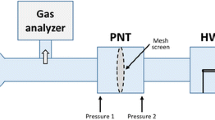Abstract
In order to determine the respiratory effects of sevoflurane in humans, breathing pattern and mechanical behavior of respiratory system were investigated in ten subjects at anesthetic depth of 1 MAC (minimum alveolar concentration). Average tidal volume and breathing frequency amounted to 275 ml and 20.9 breaths per minute. Arterial carbon dioxide tension amounted to 45.6 mmHg. Duration of inspiration was 1.06s and that of expiration was 1.92s. Mean inspiratory flow rate amounted to 259 ml·s−1. Average value of passive respiratory elastance determined by the method of Zin et al. amounted to 21.8 cmH2O·l −1, while those of active respiratory elastance and resistance obtained by the method of Behrakis et al. were 28.0 cmH2O·l −1 and 3.15 cmH2O·l −1, respectively.
Values of these variables were compared to those reported in halothane and enflurane anesthesia and possible explanations of the differences between the anesthetics are discussed.
Similar content being viewed by others
References
Behrakis PK, Higgs BD, Baydur A, Zin WA, and Milic-Emili J: Active inspiratory impedance in halothane-anesthetized humans. J Appl Physiol 54:1477–1481, 1983
Siafakas NM, Peslin R, Bonora M, Gautier H, Duron B, and Milic-Emili J: Phrenic activity, respiratory pressures, and volume changes in cats. J Appl Physiol 51:109–121, 1981
Izumi Y, Kochi T, and Mizuguchi T: Comparison of the respiratory depressant effect of halothane and enflurane in humans. J Jap Soc Clin Anesth 10:186–192, 1990
Byrick RJ, and Janssen EG: Respiratory waveform and rebreathing in Tpiece circuits: a comparison of enflurane and halothane waveforms. Anesthesiology 53:371–378, 1980
Zin WA, Pengelly LD, and Milic-Emili J: Single-breath method for measurement of respiratory mechanics in anesthetized animals. J Appl Physiol 52:1266–1271, 1982
Doi M, and Ikeda K: Respiratory effects of sevoflurane. Anesth Analg 66:241–244, 1987
Drummond GB: Comparison of decreases in ventilation caused by enflurane and fentanyl during anaesthesia. Br J Anaesth 55:825–835, 1983
Paskin S, Skovsted P, and Smith TC: Failure of the Hering-Breuer reflex to account for tachypnea in anesthetized man: A survey of halothane, fluroxene, methoxyflurane, and cyclopropane.Anesthesiology 29:550–558, 1968
Milic-Emili J, Grassino AE, and Whitelaw WA: Measurement and testing of respiratory drive. In: Regulation of Breathing Part II, Lung biology in health and disease. vol 17, Edited by Hornbein TF New York Marcell Dekker, 1981, p. 675
Hewlett AM, Hulands GH, Nunn JF, and Heath JR: Functional residual capacity during anaesthesia. II: Spontaneous respiration. Br J Anaesth 46:486–494, 1974
Westbrook PR, Stubbs SE, Sessler AD, Rheder K, and Hyatt RE: Effects of anesthesia and muscle paralysis on respiratory mechanics in normal man. J Appl Physiol 34:81–86, 1973
Waud BE, and Waud DR: Effects of volatile anesthetics on directly and indirectly stimulated skeletal muscle. Anesthesiology 50:103–110, 1979
Cherniack NS, and Altose MD: Respiratory responses to ventilatory loading. In: Regulation of Beathing, Part II Lung biology in health and disease vol 17, Edited by Hornbein TF New York Marcell-Dekker, 1981, p. 905
Higgs BD, and Carli F: An analysis of the ventilatory response to carbon dioxide with halothane and isoflurane anesthesia. Anesthesiology 59:A487, 1983
Gautier H, Bonora M, and Zaoui D: Influence of halothane on control of breathing in intact and decerebrated cats. J Appl Physiol 63:546–553, 1987
Shapiro HM, Greenberg JH, and Reivich M: Local cerebral glucose utilization during anesthesia. In: Blood Flow and Metabolism in the Brain, Edited by Harper M, Jannet B, Miller D, et al. Edinburgh, Churchil-Livingstone, 1975, p. 9.42
Author information
Authors and Affiliations
About this article
Cite this article
Izumi, Y., Kochi, T., Isono, S. et al. Breathing pattern and respiratory mechanics in sevoflurane-anesthetized humans. J Anesth 4, 343–349 (1990). https://doi.org/10.1007/s0054000040343
Received:
Accepted:
Issue Date:
DOI: https://doi.org/10.1007/s0054000040343




